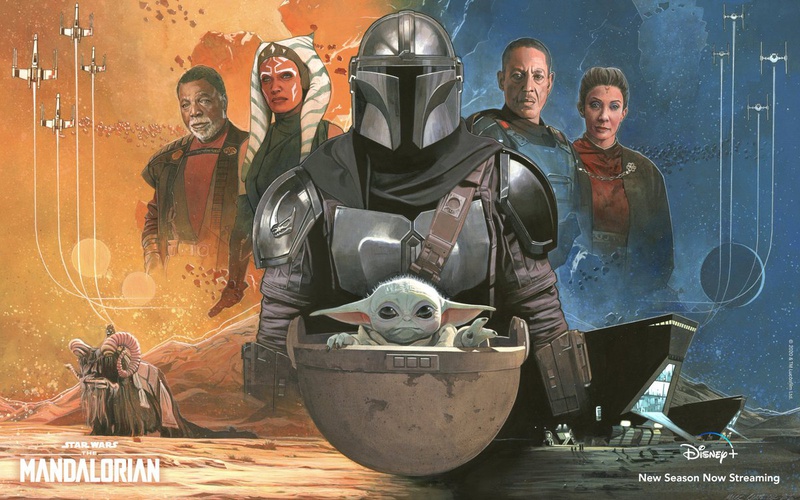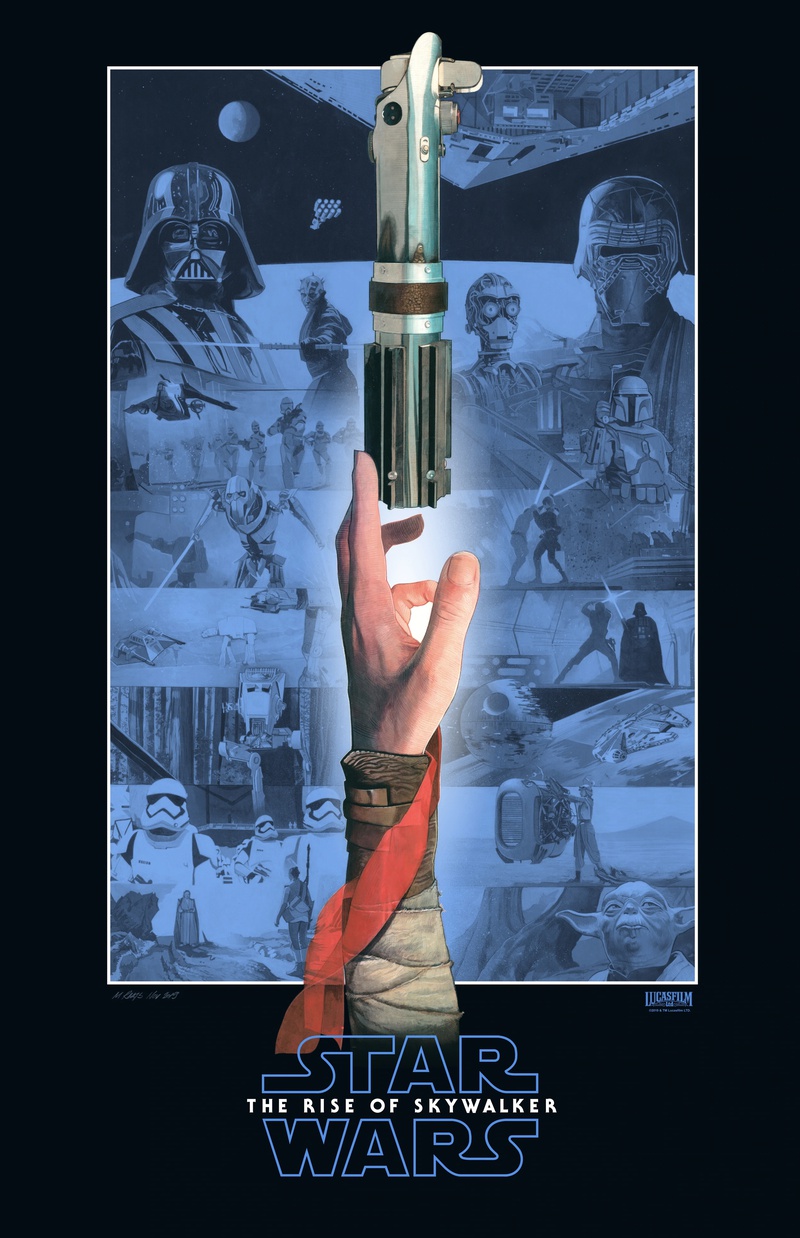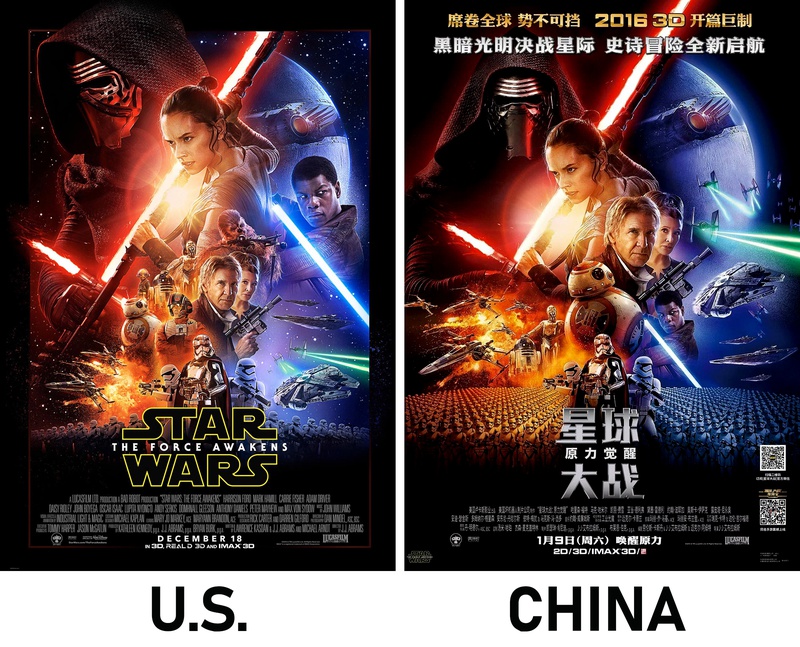
Mark Raats, Australian-based poster artist, has working with Lucasfilm for decades, painting promotional posters for the studio's Star Wars and Indiana Jones franchises.
A promotional poster for Season 2 of The Mandalorian which Raats created was shared with fans in late December, shortly after the season's finale.

Raats recently sat down with The Direct and generously spoke about his instinct for poster-making, his work as a commercial artist, and his future ahead with Lucasfilm.
This is the second part of a two-part interview. The first part of this interview can be viewed here.
The Direct: I love the poster you created for The Rise of Skywalker. Talk about a challenge trying to incorporate the entire Skywalker Saga into one poster. What do you think is necessary for a great movie poster?
Raats: A movie poster, in my opinion, has to invite the viewer into the story and try to give them an enthusiasm about what the film is trying to depict. And if I succeed in that, then I'm happy. So for example, Solo was a particularly unique one because none of the actors that were featured in the movie were known for having - for Star Wars at all. They were known for other things - but they weren't known for Star Wars. So it's not like I could have a picture of Mark Hamill or Harrison Ford or Carrie Fisher in there because although people know the characters, they don't associate them with Star Wars.

So what I've tried to do with all of them is try and capture what for me is the spirit of the movie or the saga or the genre, rather than necessarily the specifics about the movie. With Solo, I didn't include any of the actors by way of their faces. For me, It wouldn't necessarily make people want to see the movie. But what I did do is include Chewie. Everyone loves Chewie and knows Chewie. So Chewie is the only character in the whole poster who really the audience can identify with as being part of the saga and as well as being a character in his own right. And so for that one, it was important to do that, and I was very happy that the fans reacted well to that.
I'm never going to keep everybody happy. I think that is something I'm perfectly comfortable with. I do my best, obviously, and I certainly respect the fans' devotion to the franchises. But you know Disney told me with one of them, I think it was The Rise of Skywalker, when that one was revealed 25 million people saw it within the first ten minutes. You know, that it is quite a daunting figure because if you think about the number of people who you could disappoint, you could get quite concerned. But I think my main objective is to keep the studios happy. If they're happy then obviously that's important. And if after the poster's released and the fans are generally happy, you know, I've done my job.
And certainly, I've been fortunate because I don't think anything that I've done has come away with massive backlash from any of the fans. It will always be a small fraction who will want something different, but for the most part, they're happy. So that, for me, is the most important aspect of creating a movie poster.
The Direct: You've definitely captured the spirit of those films, so you've accomplished that for sure. And what a great perspective on realizing you're not going to make everybody happy.
Raats: Yeah, a lot of the fans assume that the final decision is always the artist, and it's not. I would've had a very different take on the one I did on The Mandalorian had I been just allowed to do it on my own. But I have to respect the fact — and it's something artists need to realize — that if you're going to work in this industry you gotta understand that you're part of a huge engine driving all of these franchises.
And therefore, though your opinion might be important — and it is important to push back if you feel particularly strongly about something — it isn't your decision ultimately. They will decide who or what has to go into it and how. And they will decide in fact if they are happy with what goes out. So the artists often receive a lot of backlash, and I'm not fortunately not one of them; I see some of the blogs where artists are absolutely caned for something that they do. But the truth of the matter is that it's not the artist's decision. It's the artist's decision to be part of this machine. And there a lot of other people who are involved. So you know that is something that's very important to me.
The Direct: My last question is: Do you have anything in the works we can look forward to?
Raats: Well, we're always speaking about things. There's nothing specific that I can say publicly at this point in time. It's always a huge honor to be invited back. And one must also remember that in today's world painted artwork isn't always ideal for how merchandising and marketing is done these days. So for me to be able to do these poster designs for franchises for Lucasfilm, Star Wars, Indiana Ones, Blade Runner, or Back to the Future even. It's actually a very rare privilege to be able to paint them.
Now I choose to paint them specifically because I could work in digital. I've been working in digital since 1982. I started in digital when it was very early, and I still work digitally today for other aspects of the artwork that I do. But definitely don't use it for the poster art that I do — or any of the movie art that I do — because for me the movie art has a certain legacy that's emboldened and enhanced by traditional artwork. Now there's a lot of lamenting online about the fact colleagues and friends of mine like Drew Struzan or John Erlend or Bob Peak — that their artwork is no longer the default way poster work is done.
But fans need to realize the fact that in today's world — where you've got the same artwork being sent all over the world and also being rearranged for different countries — for example, I think in China for The Force Awakens they wanted John Boyega smaller and Harrison Ford bigger. So if you've got a layered PSD digital file, anyone can move those around and it doesn't break the brand. It doesn't change the brand. All they're doing is reordering things.

There's also different aspect ratios. You've got long, thin formats that are horizontal. You've got very long thin ones that might be those tiny little billboard ones that might — for example, have Grauman's China Theater in Los Angeles. Or LCD panels, or web banners. Email banners.
So things need to be changed around. Now you can't just do that with a traditional piece because nothing is loose. Everything changes. And that is one of the reasons digital art — as much as I lament the fact that it's used as much as it is — it is more appropriate for how marketing is done today. And so to be able to do what I do, and be invited to do the projects that I do, is a huge privilege because it is rare. And it's something I will relish every time they come back and ask me to do it.
This interview has been edited for length and clarity.












